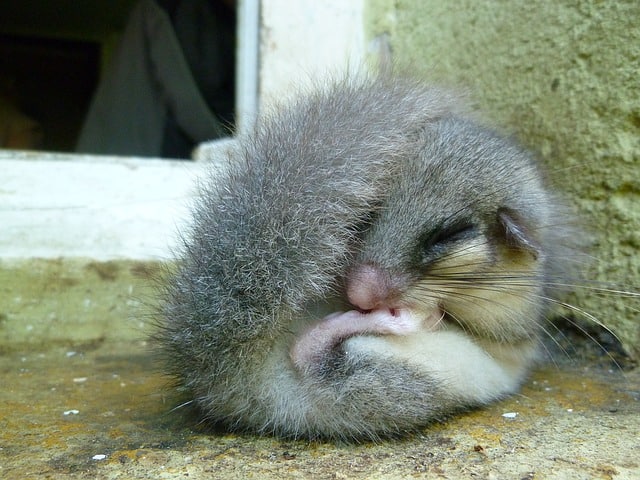
Dormouse : characteristics, habits and curiosities to learn more about this cute animal, with the reputation of being a great sleeper!
The dormouse is a nocturnal animal , just like foxes, deer , badgers and many others. This mammal belongs to the class of rodents , of which it represents one of the oldest specimens existing on Earth. It is of the Gliridae family, Glis species .
We all, at least once, have made fun of someone by giving them the nickname of “dormouse”. In fact, this term has become synonymous with “sleepyhead” , precisely because the dormouse hibernates for many months and loves to stay holed up in its shelter even during the day.
Dormouse: appearance
The dormouse is a small animal , it does not exceed 30 cm in length. Its appearance is very similar to that of the squirrel.
It has very small and round ears. The muzzle is elongated and ends with the whiskers , tactile organs like those found in cats . The eyes are dark and the incisors are very sharp , thanks to which it can actually gnaw wood.
The body is entirely covered with a gray and brown fur, which becomes white in the belly part.
The tail is also up to 15 cm long and is very bushy. The weight ranges from 70 to 180 grams. It lives an average of 6 years , but often die sooner.
Reproduction
The dormouse becomes an adult at 10 months and mates at the end of hibernation, in spring , but also in autumn .
The females rather give birth only once a year and pregnancy lasts just a month. The puppies are born in the summer from a minimum of 2 to 8 .
As soon as they are born, the young are blind and hairless and stay with their mother in the den. After about 3 weeks they are weaned and ready to start their life as adults.
The den where the mother looks after her children is built on the top of the trees, so as not to be reached by predators. It is therefore a different shelter from the one used during hibernation , which on the contrary is located further down.
In some cases, the hibernation den is also built in abandoned barns, in underground cavities and wherever they can find a corner that offers shelter.
Habits of the dormouse
Their nest is a favorite place for this mammal, since they spend practically all day there. The dormouse comes out into the open air only after sunset , while as soon as dawn comes, it goes into hiding. This is why it is so difficult to meet them.
What does dormouse eat?
Eat hazelnuts , chestnuts, acorns, berries, berries, eggs from other animals. In particular cases, some insects may even eat. Before hibernating, it is easy to see him near a hazel, intent on making provisions. Sometimes you will see an image of a dormouse on the net apparently intent on sniffing bouquets of flowers: in reality, that dormouse is having a small afternoon snack, because it also feeds on flowers.
Where does dormouse live
The dormouse lives in many areas of Asia and Europe , such as the northern part of Iran, Spain and France. In Italy we find it a little everywhere, even in Sicily and Sardinia.
Its natural habitat is given by the forests , especially the trees . In fact, it is in their cavities that it builds its nest using leaves, pieces of bark and moss.
Today we can also find them in inhabited areas, perhaps near parks, gardens or large expanses. They generally live together with other specimens of the species, preferring to stay in small groups . They love to fight for fun and chase each other.
The dormouse hibernation and lethargy
Hibernation lasts approximately 6-7 months but is not a long, uninterrupted sleep. The dormouse wakes up periodically to be able to eat what it has accumulated inside its lair.
In fact, already in autumn he goes hunting for food in order to have a good supply during the winter.
When hibernation begins, the dormouse sleeps all curled up on itself, in order to maintain a constant body temperature and minimize metabolism.
Facts about the dormouse
Here are some things that not everyone knows that will help us get to know this pet better.
- Since 2006 this animal has been recognized in Italy as a protected species , far behind what has been done in other countries (for example in Great Britain they have been since 1993). For centuries the dormouse has been hunted , as its meat is apparently very well known for being tender. The ancient Romans consumed it frequently.
- We speak of dormice as if it were a single species with homogeneous characteristics all over the world. In reality, there are almost thirty species of dormice, quite differentiated by characteristics. Some species are larger, while others have dark masks around their eyes, almost like raccoons .
- A rather surprising thing as we said at the beginning is that, despite their innocent and defenseless appearance, dormice are among the oldest rodent species on the planet. Dormice fossils have been found dating back to the early Eocene, a period of 33-56 million years ago. This therefore means that dormice were already living in a period where the ancestors of horses and some primates existed.
- One thing that not everyone knows is that this little rodent is quite noisy : it constantly emits squeaks, both while it carries out its activities and when it sleeps.
- On the other hand, when it is in danger , it is able to lose part of its tail to avoid being grabbed by predators. It also assumes a characteristic position : erect, it begins to clap its paws as if clapping and produces a kind of buzz.






